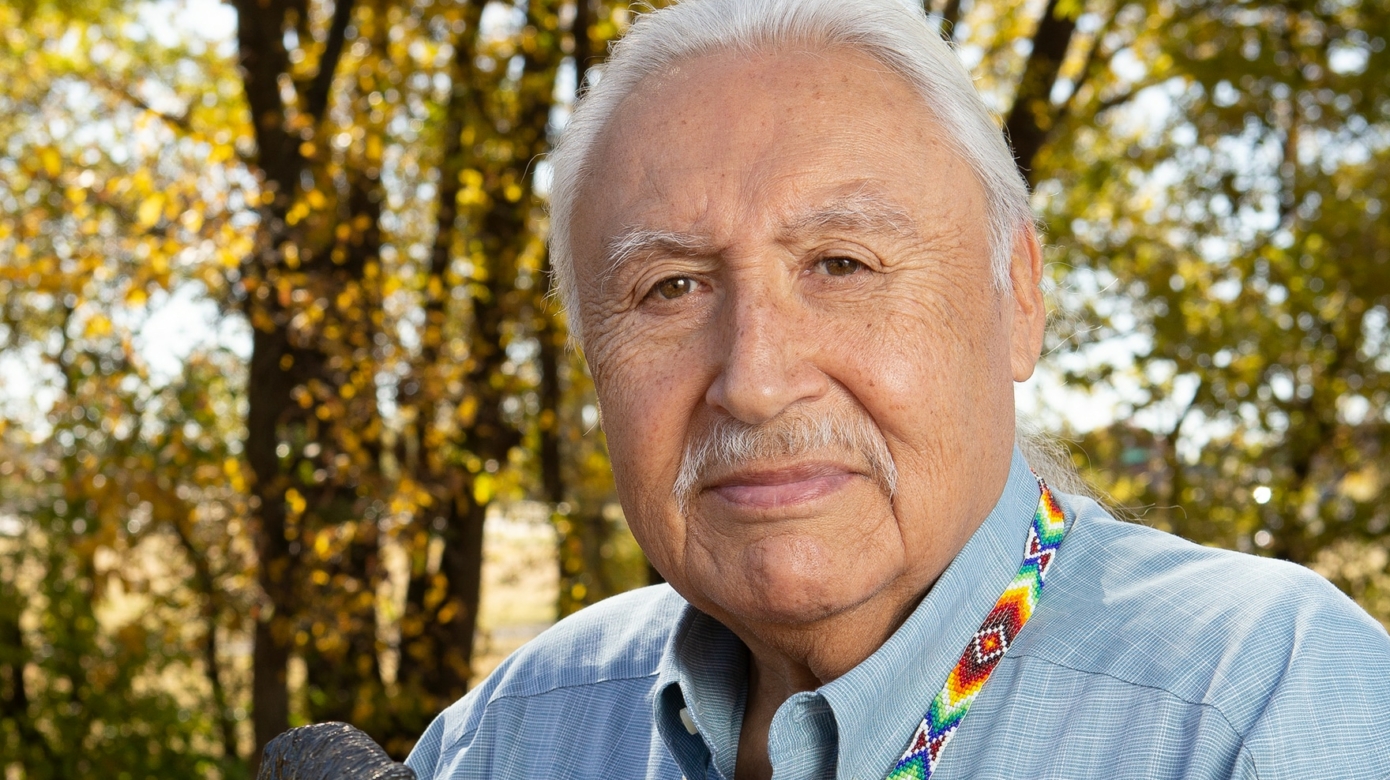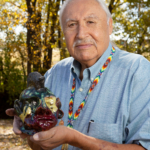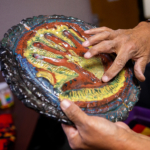Kiowa artist Burt Patadal has made many ceramic pieces throughout the last 30 years, providing others the opportunity to hold a work of art molded by his hands. In his full-time job, Patadal serves as the re-entry and diversionary lead counselor for the Citizen Potawatomi Nation Workforce Development & Social Services’ Tribal Re-entry Program.
He teaches prisoners to consider the consequences of their choices and prepares them for a life outside of the judicial system. Much of his artistic work highlights the same lessons Patadal presents to his clients. He enjoys interpreting Native American culture in his ceramics as well.
“I used to do artwork more, but when I found (ceramics) — this was my passion because I like working with colors, and I like putting history into it,” Patadal said.
During an interview with the Hownikan, he discussed one creation the size of a large dinner plate. Patadal surrounded an impression of his hand with images of everyday life. Then he broke it down the middle — a representation of abuse, drug addiction and alcoholism.
“Then you have a crack in your whole life that tears the whole family up,” he said. “It don’t just do the one certain person. It makes havoc in the family – the cousins, the uncles, the aunts, mom and dad, grandpa and grandma.”
History and culture
Patadal always had creative outlets, such as drawing and painting, and took up ceramics as a Rose State College student in Midwest City, Oklahoma. While on campus one day in the late 1990s, he saw a woman building a ceramic cowboy.
“She said, ‘You can do anything. This is easy artwork. But you just got to know how to put the colors in,’ so I signed up for that class,” Patadal said.
He quickly discovered the difficulty of using blue with ceramics. Patadal experimented and eventually learned how to show off the clay’s natural beauty while also making his point with different hues. One of his pieces uses greens, blues, yellows and blacks as a call for the viewer to revere nature.
“It’s like the ocean, the clouds, the darkness, the light. And you take care of Mother Earth because she knows what’s going on,” Patadal said.
Many of his pieces use colors to express emotion or as a small detail explaining a tribal tradition. He began reading about the Potawatomi and the Trail of Death around the same time he started making ceramics. The Nation’s story of moving from Kansas to present-day Oklahoma to take allotments and the chance to become U.S. citizens grabbed his attention as well.
He has created several pieces teaching the Tribe’s history. One depicts a Potawatomi warrior wearing a roach, a headdress reserved for warriors in many tribes. Traditionally comprised of porcupine hair to intimidate enemies, they are now often worn by powwow dancers. Their meaning, significance and use has changed over generations due to cultural disconnect and differing traditions in each tribe.
“My grandpa taught me all this,” Patadal said, regarding Kiowa roach traditions. “When you wear a roach, you’ve got to be a veteran. You can wear a roach with no feathers if you was in the service. But if you went overseas, you can wear them down. But when you kill somebody in combat, you can wear it up.”
As an avid storyteller, Patadal gladly held pieces and told their origin or meaning during a recent Hownikan interview. Many show Indigenous people’s struggle, including one with a single tear running down a man’s face.
“This guy is in a lot of pain; he’s suffering for his people. You can see in his face, he’s come a long way,” he said.
Money and motivations
Patadal never sells his art; he always trades. He has received everything from guns and ammunition to other artworks for one of his ceramic pieces. This rule plays into several of his life mantras.
“Some people, it’s all about money. It’s not about money (to me). It’s about Creator. You helping your fellow man. … We’re here to help one another,” he said.
People sometimes commission Patadal to create a piece or painting for them, and they decide how to swap goods or services. He tries not to refuse requests.
“In my Kiowa ways, if somebody asks you to do something, you don’t turn them down,” he said.
Patadal also teaches participants of the re-entry program about the separation of personal interests and self-sufficiency.
“You do your artwork as a hobby. … I have to have a good job and working and making money. I just really just did this on the side — spur of the moment,” he said.
“You’ve got to prepare for tomorrow and the future. You can’t just live one day at a time.”
However, Patadal knows the importance of a creative outlet such as ceramics. He encourages the participants to find something, such as art, that they enjoy as a step in their recovery and re-entry process.
“I tell them, (they) say, ‘I just can’t do this.’ I said, ‘Wait a minute, wait a minute. Why can’t you do this? I don’t want to hear the word can’t.’ Walk before you can run. … Get your mind set on what you can do,” he said.
He hopes to retire from CPN in the future and invest in a kiln to create more.
Prayer and the Red Road
Although Patadal began work at the John H. Lilley Correctional Center in Boley, Oklahoma, in 2006, he attained the title of Indian Chaplin of the facility earlier this summer.
“(I) just help a lot of prisoners. They want to talk, and (I) talk to them. And they want to pray, we’ll pray. If we want to sing an Indian song, we’ll sing an Indian song,” Patadal said.
Frank Gregory, the facility’s preacher and chaplain for the past two years, noticed Patadal’s work and suggested he receive the title. Patadal uses the same experiences that influence and inspire his art to teach the Native American inmates customs, history and how to walk the Red Road.
“(I) try to talk nice to them, find out what’s going on in their life and how we can make it better for them. And the only way I know is to tell them, ‘Walk the Red Road.’ If you do things good in your life and you try to help people and do things right, you’ll be a better person,” Patadal said.
He holds purification lodges and talking circles for those who want to participate and treat the gatherings with respect. He also screens educational films about Indigenous history.
“Then that’s a light that comes on because most Indians, when you’re growing up, you know something about your tribe or about yourself, what they teach you,” Patadal said; however, he has found in recent years, many of them lack those customs and knowledge.
Patadal also teaches self-control through prayer to the Creator.
“I’ll say, ‘You need to find your triggers — what’s going on, what makes you mad, what makes you tick — and you need to resolve it.’ And I said, ‘Like it says in the Bible, the truth will set you free,’” he explained.
Patadal believes in the interconnectedness of all beings on Earth. He emphasizes prayer as a time to be humble, reflective and honest about life and those connections.
“If you’re going to do something, do it right because prayer is everything. Prayer’s going help you out a million and one. And helping people is going to help you out. If you don’t help people, and you just stick to yourself, you’re … not doing (Creator’s) work,” Patadal said.
Between his duties as the correctional center and job, Patadal has less time for ceramics than he used to. For now, he plans to continue helping those who are incarcerated and enjoy his new title of Indian Chaplain.
“I’m glad somebody finally recognized me, you know?” he said.
Visit cpn.news/WFSS to read more about the Citizen Potawatomi Nation Workforce Development & Social Services Re-entry Program.



